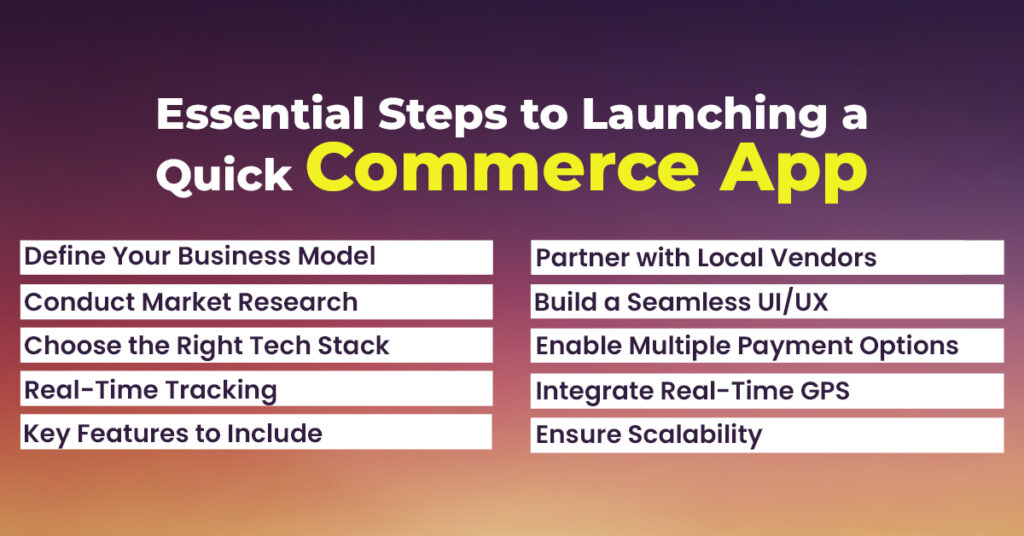The eCommerce industry has witnessed massive growth over the past decade, with platforms like Amazon, Flipkart, and Myntra leading the digital shopping revolution. However, post-2020, consumer behavior took a sharp turn—demanding not just convenience but instant gratification. This shift gave rise to Quick Commerce (Q-Commerce)—a new-age model that delivers essentials like groceries, food, and daily needs in under 10 minutes.
Brands like Blinkit (formerly Grofers), Swiggy Instamart, and Zepto are now redefining shopping expectations with ultra-fast delivery services and hyperlocal fulfillment models. Powered by dark stores, real-time inventory updates, and last-mile optimization, quick commerce has not only disrupted traditional eCommerce but is also building a parallel economy valued in billions.
As we enter 2025, the quick commerce wave is only growing stronger. This blog will guide you through how to start your own quick commerce business, what tech stack and logistics are needed, how to build a strong user base, and ways to monetize your delivery app. Whether you’re an entrepreneur or a brand looking to scale digitally, understanding Q-Commerce can help you capitalize on this evolving trend and dominate your niche with speed, service, and scalability.
The rise of instant delivery services has reshaped customer expectations, making speed the new standard. Whether it’s groceries, meals, or essentials—consumers want them delivered in minutes. If you’re planning to start a quick commerce business, developing a robust app with the help of Quick Commerce App Development Company is your first and most important step. Here’s a comprehensive look at how to build a successful quick commerce application.
Building a Quick Commerce App: Key Steps to Success

Define Your Business Model
Before jumping into development, clearly define your business model. Are you focusing on groceries, medicine, food, or multi-category deliveries? Will you operate your own dark stores or partner with local vendors? These decisions influence the app’s architecture, features, and backend systems.
Conduct Market Research & Competitor Analysis
Analyze competitors like Zepto, Blinkit, and Swiggy Instamart. Identify what they do well and where they fall short. Customer reviews, app store feedback, and industry reports are valuable resources. Use this research to find a unique value proposition for your app.
Choose the Right Tech Stack
The performance of your app hinges on your technology stack. For scalable, real-time features, use:
Frontend: React Native or Flutter
Backend: Node.js, Express.js
Database: MongoDB or PostgreSQL
Cloud Hosting: AWS or Google Cloud
Real-Time Tracking: Socket.IO or Firebase
The tech stack should allow seamless performance even during high-traffic situations, while enabling rapid updates and integration capabilities.
Key Features to Include
To meet user expectations, your app should include:
User Panel:
- Easy onboarding
- Real-time order tracking
- Multiple payment methods
- In-app support and chat
Rewards, coins, and promo codes
Delivery Agent App:
- Route optimization
- Delivery status updates
- Payout tracking
- Availability toggles
Admin Panel:
- Inventory and product management
- Live analytics
- Order management
- Customer and delivery support tools
Partner with Local Vendors or Set Up Dark Stores
Quick commerce relies on proximity. You can either set up dark stores stocked with popular items or tie up with local businesses for fast fulfillment. Ensure that inventory data is synced in real-time with your app to prevent order issues and delays.
Build a Seamless UI/UX
An intuitive interface is non-negotiable in quick commerce. The customer journey—from opening the app to placing an order—should take no more than 2-3 taps. Optimize user flow, use engaging visuals, and minimize loading times to keep users coming back.
Enable Multiple Payment Options
Quick commerce thrives on convenience. Offering secure and flexible payment options—UPI, cards, wallets, and cash on delivery—improves conversions. Integrate trusted gateways and ensure PCI-DSS compliance for user trust.
Integrate Real-Time GPS & Notification System
Fast deliveries require accurate and real-time location tracking for both customers and delivery agents. Push notifications for order confirmations, ETAs, and promotional offers are also key to user engagement.
Ensure Scalability and Security
Your app must be ready to scale as user demand grows. Cloud infrastructure, microservices architecture, and a secure data policy are critical. Compliance with data protection laws (GDPR, local regulations) should be prioritized from day one.
Launch, Test, and Iterate
Soft launch your app in a limited area, collect feedback, and optimize accordingly. Fix bugs, improve features based on user input, and scale gradually. Post-launch, focus on marketing strategies like referral programs, app store optimization, and local partnerships.
Key Differences Between eCommerce and Quick Commerce
| Aspect | eCommerce | Quick Commerce |
| Delivery Time | 1–2 days or more | 10–30 minutes |
| Product Focus | Wide variety: electronics, fashion, etc. | Daily essentials: groceries, snacks, medicines |
| Order Planning | Often planned purchases | Instant, need-based purchases |
| Inventory Management | Centralized warehouses | Hyperlocal dark stores |
| Logistics Model | Long-distance delivery | Last-mile delivery within limited radius |
| Customer Expectation | Variety, pricing, convenience | Speed, availability, immediate access |
| Examples | Amazon, Flipkart, Myntra | Zepto, Blinkit, Swiggy Instamart |
| Business Strategy | Bulk orders, deals, and seasonal offers | Fast delivery, real-time stock, and localized service |
Build Fast, Deliver Faster with SYNARION: A Quick Commerce App Development Company
Custom App Development
We build delivery apps tailored to your business model—whether it’s groceries, essentials, or pharmacy. Get a fully branded solution that aligns with your goals.
Next-Gen Tech Stack
Using Flutter, Node.js, MongoDB, and AWS, we create robust, scalable apps that deliver seamless performance—even during peak loads.
Real-Time Tracking
Our apps feature real-time order tracking, smart geo-fencing, and route optimization to ensure lightning-fast deliveries every time.
Multiple Payment Integrations
Offer your users flexibility with integrated payment gateways supporting UPI, wallets, cards, and COD.
Admin & Vendor Panel
Manage your business with ease using powerful dashboards, analytics, and controls for admins, vendors, and delivery agents.
Ongoing Support & Maintenance
Post-launch, we stay with you—offering upgrades, bug fixes, and performance tuning to keep your app smooth and updated.
Frequently Asked Questions
1. Is Investing in a Quick Commerce Business Profitable in 2025?
Yes, with rising demand for instant delivery, investing in Q-commerce offers high growth potential, especially in urban areas.
2. Which Q-Commerce Platforms Are Dominating the Market?
Zepto, Blinkit, Swiggy Instamart, and Dunzo are leading Q-commerce platforms offering ultra-fast delivery across major cities.
3. How Can You Market a Blinkit-Like App Successfully in 2025?
Leverage social media, influencer marketing, local partnerships, referral programs, and app-based offers to attract and retain users.
4. What Are the Essential Features Required for a Quick Commerce App?
Real-time tracking, quick checkout, multiple payment options, order scheduling, push notifications, and a strong admin dashboard.
5. How Does Quick Commerce Impact Consumer Behavior and Expectations?
It raises the bar for speed and convenience, making instant delivery a new norm and increasing expectations for faster service.






What do you think?
It is nice to know your opinion. Leave a comment.